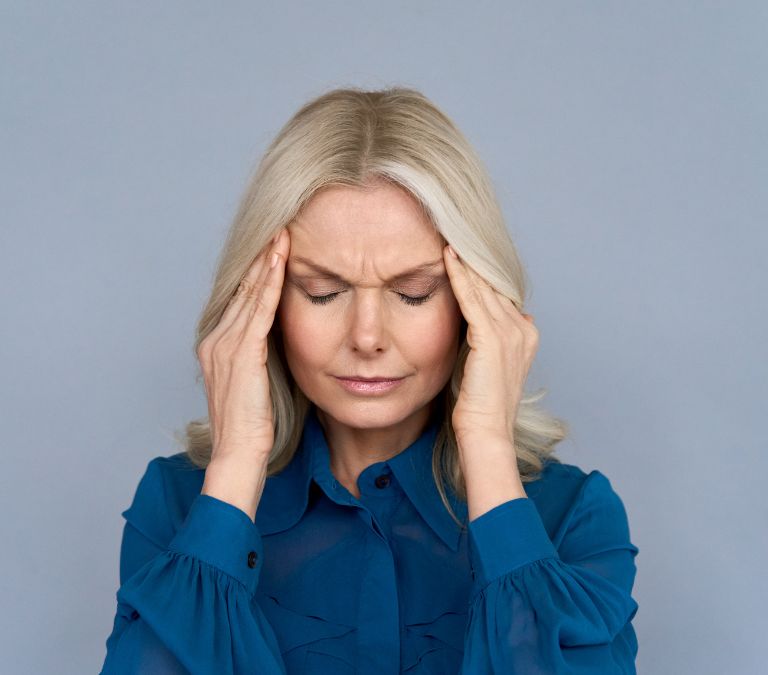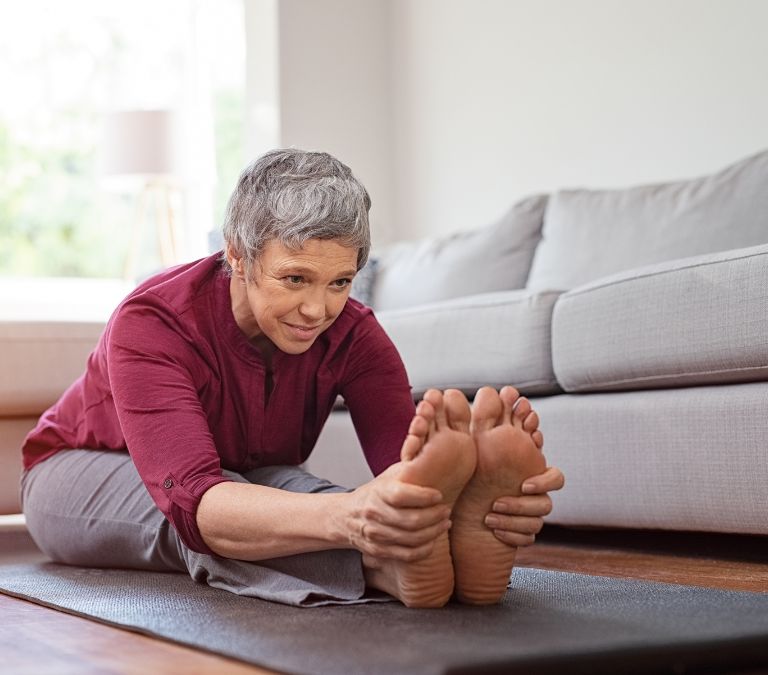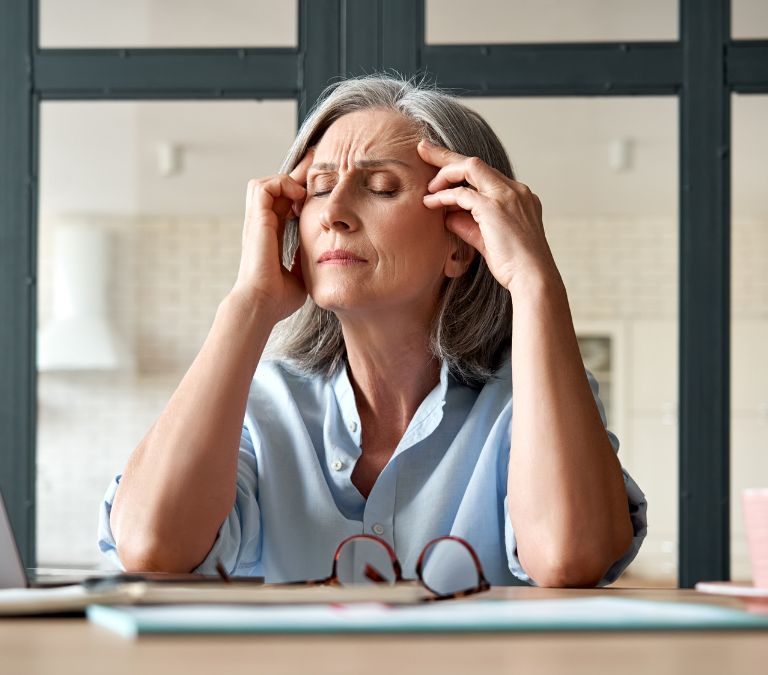Having headaches, especially migraines, is common for women during hormonal fluctuations. A woman’s reproductive hormone (estrogen) is known to be closely related to the event of headaches. Therefore, the female may frequently or rarely experience migraines throughout her reproductive life, depending on individual body makeup.
Due to this hormone factor, health statistics show that the average female is three times more likely to have migraines in a lifetime than the average male.
During pregnancy and menopause, there may be much more frequent periods of suffering from migraine headaches. However, this differs from woman to woman.
These headaches, which you may not be able to elude exclusively, can be managed. You should read on if you’re going through this stage or know someone you can help.
Table of Contents
- Menopause, perimenopause, and migraines
- Causes of perimenopause headaches
- Dealing with menopause and migraines
- Top 5 exercises that will relieve you of headaches and migraines during perimenopause and menopause
- Top 5 foods that will reduce your headaches and migraines during perimenopause and menopause
- Vitamins that will reduce your headaches and migraines during perimenopause and menopause
- Frequently asked questions on menopause headaches.
Menopause, Perimenopause, and Migraines
Headaches can be a symptom of menopause. Estrogen levels fall to a bare low degree of production at the menopause stage of life (most of the time around the age of 40s or 50s and beyond). After all, your body doesn’t need the hormone anymore than it used to.
Perimenopause means “around menopause.” It is also called the menopausal transition stage and is the beginning and end of a woman’s reproductive years. It is the stage in a woman’s life just before she attains menopause – the “premenopausal” stage. And in this stage, the estrogen levels also begin to drop, and frequent headaches may occur acutely or chronically, or maybe both.
However, migraines are the most common headaches associated with hormone levels. So, if you have attained menopause or are about to, know that it’s perfectly normal to have these migraine attacks, but you can do something about it.
Not every headache you feel – slight or severe, during your menopausal years is probably a migraine; talk less of being a menopause-related headache. So, proper diagnosis by yourself and a doctor or medical professional should take its course so you know what you are dealing with. In addition, headaches could be symptoms of other underlying health issues, even if we don’t hope for anything worse.
Causes of perimenopause headaches

Frequent headaches may occur during the transition from reproductive age to menopause due to the recurring rises and drops in estrogen levels in the woman’s body.
It is primarily the case with women who have had many hormone-related headaches.
While some women experience menstrual headaches and similar hormone-related symptoms during or before menstrual periods, the phenomenon is foreign or rare to others.
The common cause of hormone-related migraine headaches is the sharp drop in estrogen concentration during the years leading to menopause. Still, even a rise in the levels at some point can trigger the headaches to set in. So, only steady levels of the hormone circulating would guarantee the absence of the headaches.
There are yet other triggers that can set off or worsen migraines, and if you frequently experience these headaches, you might want to watch out for these:
Stress
Indulging in activities that build up stress daily may trigger headaches on a typical day, even without hormonal fluctuations in the body. The likelihoods are far more likely when a woman goes through her menstrual periods, perimenopause, or actual menopause.
While you may not entirely prevent hormonal headaches, cutting back on stressful activities should reduce the risks to a manageable level.
Anxiety
Like many other negative emotions, anxiety and worrying trigger headaches and, worse so, perimenopausal migraines.
Dehydration
Depriving the body of fluids can cause or worsen migraine headaches. The body requires a good balance of electrolytes in a fluid medium to function correctly. When the body is dehydrated, the brain may shrink in size away from the skull. It results in a compression feeling in the head, otherwise called a dehydration headache.
During menopause or perimenopause, a slight change in body hydration levels can trigger the onset of the menopausal migraines or worsen already manifesting headaches.
Rehydrating your body by drinking enough water or fluids will restore the body’s hydro osmotic balance and possibly relieve headaches.
Poor posture
Taking poor posture during day-to-day activities, whether at home, in the office, or elsewhere, even in trivial things such as pressing your phone or other digital devices, can have acute or long-term impacts on the frequency and severity of migraines, especially during the symptomatic post-reproductive years in life.
Poor dieting
Certain foods or edible substances have positive or negative effects in relieving or triggering migraines. On the other hand, substances like caffeine or alcohol have been observed through recent studies to increase headaches.
Deficiencies in certain food nutrients or observing some dieting practices, like fasting or low-calorie dieting, might set off headache experiences.
During the perimenopausal period, you may also experience other symptoms from hormonal migraines. These symptoms may include:
- Vaginal dryness: Due to the decrease in estrogen production during perimenopause, the vaginal linings may dry and thinner.
There is also less production of vaginal secretions that keep the vulva moist.
- Hot flashes: Some have described hot flashes (or hot flushes) as a sudden warmth rushing through somebody’s areas like the face, neck, or chest.
This feeling becomes a prevalent symptom during the menopause transition stage. The fluctuating estrogen levels can cause the blood vessels to dilate rapidly and sudden blood flow in the mentioned areas.
Hot flashes are usually characterized by red blotchy skin, sensations of heat, and sometimes, increased heartbeat.
- Insomnia: You may also be experiencing some sleep problems as another symptom of perimenopause. According to the National Sleep Foundation statistics, about 61% of women in menopause experience sleep problems. This problem is due to reduced cardiometabolic activity and the heat flashes and sweating experienced during perimenopause.
- Irregularity in menstrual periods: During the menopause transition stage, irregular menstrual cycles are a normal development. The body is gradually phasing out of the reproductive years, and ovulation becomes less frequent before it ceases during menopause.
Dealing with Menopause and Migraines
Migraine headaches experienced during menopause or the menopause transition period are ideally a typical and expected body change. Still, it doesn’t mean you have to suffer painfully from the symptom every time it sets in during this stage of life.
Menopausal headaches can be managed and prevented to reduce the frequency of occurrences and the severity as well.
Dealing with migraines can be achieved by either natural or lifestyle methods. Let’s see some of the forms or ways by which we can repress the medical condition.
Diet Changes and Regularity
To deal with migraine headaches that are symptomatic of the menopause stage, you can start by changing your diet. Food substances like caffeine, alcoholic beverages, cheese, and processed meats that may trigger headaches should be avoided from the menu.
Also, keep a log or diary of what you eat and the quantities to monitor how your health is affected. Suppose you observe positive improvements in reducing migraines from a specific diet or discover a new trigger unfavorably. In that case, you can formulate a new diet plan accordingly.
Ensuring that your eating is regular enough is essential to dealing with menopausal migraines as food depriving practices such as fasting can significantly deteriorate the headaches you experience.
Incorporating Acupuncture
Acupuncture has been well known over the years as a solution to the problem of migraines and other types of chronic pains. It also applies to menopause migraines.
Acupuncture is a form of traditional medicine that originated from the Chinese and was adopted by modern methods. It involves placing pressure on specific areas of the patient’s body to relieve pain and give therapy where needed.
Among many other benefits, acupuncture has proved to be a safe prophylaxis method, is cost-effective, and has therapeutic effects that last over time.
Acupuncture relieves migraines by sensitizing the nerves at the pressure points to release endorphins into the bloodstream. Endorphins are hormones that trigger responses from the body that are believed to let off tension and headache pains.
Exercising Regularly

Regular exercise also plays a role in minimizing migraines during menopause. Make efforts to indulge in physical activity about 3 to 5 times a week. You can choose simple tasks such as taking a brisk walk, swimming, or some light jogging for a few minutes every day if you decide to perform the weekly exercise routines.
Or you can opt for slightly more arduous physical activities like running, mountain biking, cycling, and many more options if you please and have the means.
Regulating your Sleep Patterns and Consistency
Sleep disorders like insomnia are side effects experienced during menopause. Insufficient sleep and irregular sleep patterns can develop into more health complications in the long run.
You can take measures to regulate your sleep patterns to ensure you still attain the required number of hours to rest your body at night.
Using Supplements and Medicines
Nutrient supplements also significantly improve recovery from and prevent migraines suffered during menopause. Certain supplements like Vitamin B2, Vitamin D, magnesium supplements, and coenzyme Q10 supplements, among others, have been shown to reduce the frequency of migraines.
Other supplements used include riboflavin and melatonin (a hormone).
You can also use some medicines or over-the-counter drugs to treat migraines. Aspirin or Ibuprofen, efficient pain relievers, can relieve migraine pains. Doctors can prescribe drugs like triptans, dihydroergotamine, lasmiditan, ubrogepant, and anti-nausea medications.
Narcotic opioids may also prove helpful, but since they are a highly addictive group of substances, they should be used only as a last resort if other medications are unavailable or cannot be used for any underlying reason.
Behavioral Therapy Methods
Another method of dealing with the headaches experienced before or during menopause is implementing behavioral therapy methods. The most common behavioral therapy types are biofeedback or relaxation therapy.
Biofeedback therapy is a biological feedback technique involving a device or physical monitor instrument that measures and records body response and feedback. At the same time, the user tries to modify the response.
In the case of stress, the body develops increased muscle tension and variation in body temperature. The biofeedback instrument picks up this stimulus. The individual can observe the body’s response to stress and modify the stress-causing circumstances.
With this, one can recognize, reduce, stop or even prevent a headache.
Relaxation therapy is the more effective and more popular therapy technique. It involves systematic but straightforward procedures to induce a relaxed state to relieve stress which is a significant builder of headaches. Relaxation therapy regulates heart rate, blood pressure, and sleep/alertness patterns by controlling the sympathetic nervous system, reducing stress and the risks of experiencing headaches.
Top 5 Exercises that will Relief You of Headaches and Migraines during Perimenopause and Menopause

Yoga
Recent medical research has shown that relaxative exercises like yoga can significantly relieve migraines. Yoga is a therapy procedure that involves mind and body control and “de-stressing,” so it becomes very effective in letting off steam that usually builds into headaches.
Cycling
Physical exercise is instrumental in reducing migraines’ severity and frequency, and cycling is an excellent example.
Jogging
Jogging is also a physical exercise that relieves one of the headaches. It is light and non-strenuous, easy to perform without equipment, and applicable indoors and outdoors.
Posture exercises
Specific posture exercises have proven helpful in fighting the occurrence or experiencing migraines set off by poor posture. If you feel your migraines are related to or caused by poor posture at home or work, a proper posture exercise will work well.
Tai chi
Tai chi is another important exercise activity in relaxing the mind and body. Tai chi improves systolic blood pressure and prevents the build-up of harmful tension that results in headaches.
Top 5 Foods That Will Relief You Of Headaches and Migraines during perimenopause and menopause

Bland foods
Foods like white bread, saltine unflavoured crackers, or pears are good for reducing nausea which can be both a symptom of migraines and a trigger for menopause headaches.
Cereals
Most cereals are good to eat for migraines except those containing aspartame, dried fruits, or nuts.
Seeds
Sunflower seeds, sesame, pumpkin seeds, and flax are good food choices to relieve migraines. These seeds are rich in vitamins and nutrients like Vitamin E and magnesium, which are necessary for the body to regulate internal conditions that prevent and reduce headaches.
Carrots
Fresh vegetables like carrots have always been beneficial in fighting migraines because of their high vitamin content.
Carrots are also known for their high water content. They are incredibly efficient since migraines are also triggered by dehydration.
Fibrous fresh fruits
Fresh fruits, veggies, and food substances are less likely to have preservatives. Preservatives potentially trigger migraine attacks, so eating fresh food is best.
High Vitamin C content, necessary for nutritional needs and reducing migraines, can also be found in these fresh and fibrous fruits and vegetables.
Other food substances that may help include fatty fish (e.g., mackerel, salmon, sardines), ginseng, ginger, peppermint, and caffeine (to a level – that may worsen migraines for some).
Some essential nutrients, minerals, and vitamins that help in relieving headaches include;
- Magnesium
- Zinc
- Selenium
- B-vitamins
- Vitamin C
- Vitamin E
Frequently Asked Questions
How do I know I have a migraine headache?
Migraines are a type of many headache types that occur in humans. Women are more likely to experience migraines, but it is not a mono-gender disorder peculiar to men. Migraines may be caused by many risk factors, including stress, diet, or hormones. The hormone-induced migraines are primarily due to fluctuations in the estrogen levels of a woman, especially a fall in the levels.
You can identify a migraine headache by observing some symptoms that are usually either peculiar to migraines or closely associated with the disorder. Migraines are characterized by
- Painful, overwhelming sensations in the head
- Oversensitivity to light or noise
- Pulsating throbbing pain
- Nausea
- Blurry visions
Are all exercises helpful in relieving menopause headaches?
Exercises are beneficial for reducing or alleviating migraines. However, the recommended activities should be light or moderate. Even if you want to do more than the average walking or jogging activity and wish to engage in something more physical and arduous, you should remember that there should be a limit, especially for people prone to experiencing headaches.
Exercise-induced migraines you get after strenuous and vigorous exercise and workout sessions like heavy weightlifting. One of the common first symptoms of exercise-induced migraines includes neck pain.
So, while trying to relieve yourself of migraine pains, be careful not to overwork it and worsen the case.
Who can have a migraine?
Migraines can occur to anyone at all, even to children. However, some factors increase the likelihood for some persons to differ from person to person.
Age is a factor – migraines tend to occur more often in persons between 18 to 44 years. So, it is less common in kids.
Genetics also plays a vital role in determining the risks of having migraines throughout one’s lifetime.
Females are also more likely to develop migraines more frequently than males.
How do blood sugar levels affect menopause headaches?
Blood sugar levels may serve to trigger the onset of migraine headaches. Generally, a fluctuation in the sugar level in the blood can cause symptoms like dizziness, fatigue, and headaches, especially if it’s a drop in the levels.
If you consume too much sugar, your blood sugar levels significantly increase, which can be a trigger for headaches.
During menopause, the woman’s body tends to be more sensitive to these internal stimuli, and even slight changes in sugar levels in the blood can set off acute menopause headaches.
Is every migraine experienced during menopause hormone-related?
Migraines become more frequent during perimenopause and menopause. That is not to say that every migraine you experience is hormone-related. The chances that what you share is a symptom of menopause are high, and it’s probably true. Still, you may need to make proper assertions and diagnoses for your health.
Some migraines are caused by very different factors or may even be symptoms of underlying illnesses. If these coincide with your menstrual periods, perimenopause, or menopause, don’t be hasty to rule it off as “hormonal.” If it is not, you can identify the cause and address it adequately to avoid the risks of allowing an undiscovered illness to complicate health issues further.
Conclusion
Menopause headaches are not so hard to identify and deal with, and it’s just one of the few side effects of age. With the know-how you already have at this point, you should be able to effectively manage and deal with them while ensuring you stay healthy.
Be sure to always confirm what type of headache symptoms you are experiencing. If it’s a migraine or not, and if it is a migraine, if it is hormone related or not, you can treat it appropriately.
You could also palace an icepack on your headache or any other body part like the back of your neck. You may be feeling pains as a treatment to reduce the pain sensation from migraines.
If you observe that a particular wave of headache persists uninterrupted despite employing many natural or lifestyle methods to deal with the headache, endeavor to see a physician for proper and further diagnosis and prognosis.







